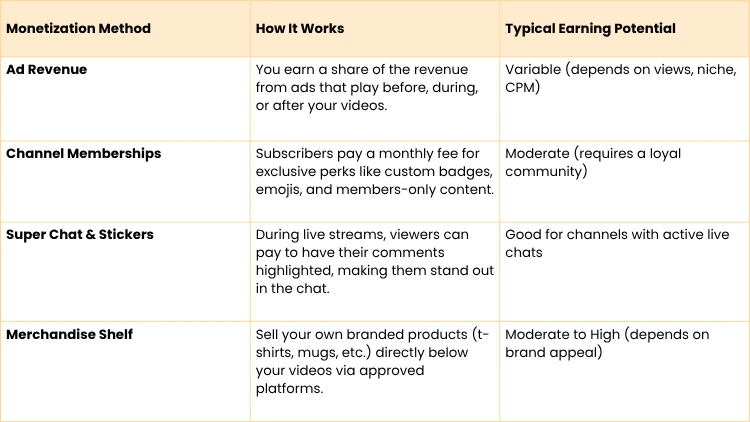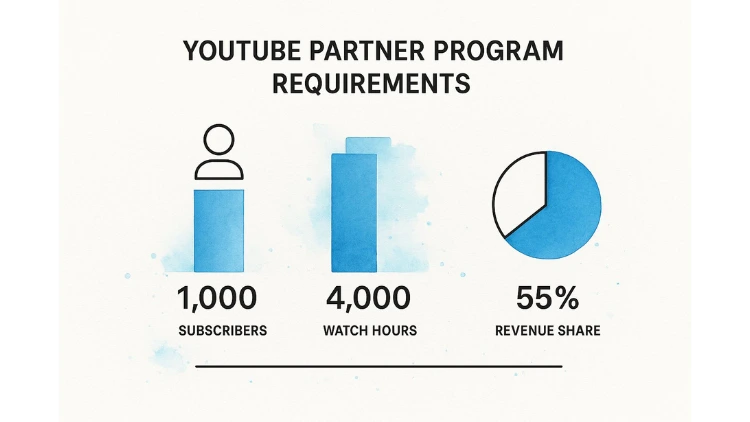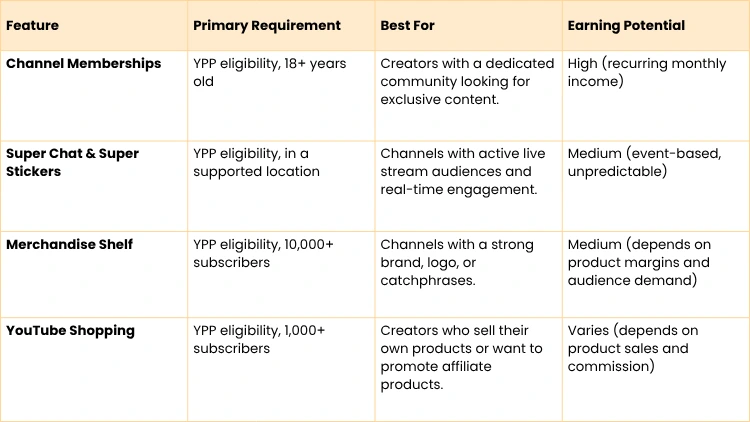How to Monetize Your YouTube Channel with Proven Strategies

So, you're ready to start making money from your YouTube channel? It's an exciting milestone, but first, you've got to clear a few hurdles set by the YouTube Partner Program (YPP).
The magic numbers you're aiming for are 1,000 subscribers and 4,000 hours of public watch time within the last 12 months. Once you hit those targets, you can apply to the YPP and unlock the ability to earn from ads, channel memberships, and a whole lot more.
Jump To Section

Earn As You Learn
Earn 25% commission when your network purchase Uplyrn courses or subscribe to our annual membership. It’s the best thing ever. Next to learning,
of course.
Your Practical Path to YouTube Monetization
Jumping into monetization can feel like a huge leap, but it’s really a step-by-step process that rewards you for being consistent and building a real connection with your audience. The main gateway here is the YouTube Partner Program. Think of it as YouTube’s way of verifying that you've actually built a community before they start placing ads on your videos.
Those initial requirements—1,000 subscribers and 4,000 watch hours—aren't just random numbers. They act as a crucial benchmark, telling YouTube that your channel has a dedicated audience and provides real, consistent value. Advertisers, after all, want their ads on channels people are genuinely watching. These metrics are your proof of concept.
Understanding the Core Milestones
Getting to 1,000 subscribers is proof that you can attract and keep a loyal following. These aren’t just casual viewers; they’re people who hit "subscribe" because they genuinely want to see more from you. Hitting this number usually means you've figured out who your audience is and what they love to watch.
The 4,000 watch hours requirement, though, is often the tougher nut to crack. This metric is all about the total time people have spent watching your content, and it’s a direct measure of how engaging your videos are. A video with thousands of views that people abandon after 10 seconds barely moves the needle. On the other hand, a video that holds someone's attention for several minutes is what really drives that watch time up. For example, ten videos that each get 1,000 views and an average watch time of 4 minutes will earn you 40,000 minutes (about 667 hours) of watch time. That's a practical, achievable target to aim for.
A common mistake is focusing solely on subscriber count. While important, watch time is the true indicator of channel health and is essential for monetization. It proves your content is compelling enough to keep people watching, which is exactly what advertisers are looking for.
Building Your Foundation for Success
Meeting these thresholds isn't about chasing a single viral hit. It’s about building a sustainable content engine that keeps people coming back. As you work towards this, it's really important to find a balance between your monetization goals and your creative vision. A great resource on this explains how to monetize content without losing your creative soul, and it offers a fantastic perspective for creators who want to earn money without selling out.
Once you’re in the YPP, a bunch of different income streams open up. Here's a quick look at the primary ways you can start earning:
Primary YouTube Monetization Channels at a Glance
This table breaks down the most common ways creators earn money directly through YouTube once they're in the Partner Program.
These tools are powerful, but they all depend on having an engaged audience first.
Before you can really dig into these tools, your main focus has to be on growth. For a detailed guide on that, check out this guide on how to grow your YouTube channel. It’s packed with proven strategies to help you hit those first monetization milestones much faster.

Meeting The YouTube Partner Program Requirements
Getting into the YouTube Partner Program (YPP) is the first major milestone for any creator looking to earn money from their channel. We all know the magic numbers: 1,000 subscribers and 4,000 hours of public watch time within the last 12 months.
But just knowing the numbers isn't a strategy. The real trick is understanding how to get there without burning out. Think of these requirements as YouTube's way of making sure you've actually built an audience before they start showing ads on your videos. It’s less about just getting views and more about earning dedicated attention from people who genuinely like what you do.
Beyond The Numbers: Strategic Growth Tactics
So many new creators get obsessed with the subscriber count. We get it, it's a vanity metric that feels good. But from experience, watch time is the tougher, and frankly, more important metric. It’s a direct signal to the YouTube algorithm that your content is compelling.
Let's break it down. A five-minute video that keeps people watching for four minutes (80% audience retention) is infinitely more valuable than a 15-minute video people abandon after just two minutes. That first video tells YouTube, "Hey, people are hooked on this!" The algorithm then starts showing it to more people, which naturally brings in more subscribers.
Engineering Higher Watch Time
You can absolutely structure your videos to keep people watching longer. This isn't about clickbait or tricks; it's about good storytelling and delivering on the promise of your title and thumbnail.
Here are a few actionable insights that work wonders for boosting watch time:
- The Powerful Hook: The first 15-30 seconds are everything. For a DIY channel, show a quick shot of the stunning finished project before you start the tutorial. For a review video, open with your final verdict. This gives viewers a reason to stick around.
- Storytelling Arcs: Even a simple "how-to" video can have a story. Show the problem (the "before"), walk through your solution (the "journey"), and reveal the amazing result (the "after"). This simple structure keeps people invested.
- Open Loops: Tease what's coming up later in the video. A simple phrase like, "And in just a minute, I'll show you the one mistake that ruins this entire process" creates curiosity and gives viewers a reason to stick around.
The single biggest lever you can pull for channel growth is Audience Retention. If you can consistently keep viewers watching for a significant portion of your videos, the YouTube algorithm will become your most powerful marketing tool, pushing your content to new audiences automatically.
Converting Viewers Into Loyal Subscribers
Getting a view is great, but earning a subscriber is a different ballgame. A subscriber is someone who's raising their hand and saying, "I want to see more from you". That requires building real trust and giving them a clear reason to commit.
The old "Don't forget to subscribe" just doesn't cut it anymore. Your call-to-action (CTA) needs to be specific and offer value.
Here are some effective CTA examples:
- For a cooking channel: "If you enjoyed this recipe, hit subscribe because next week I'm revealing my secret for perfect sourdough."
- For a tech review channel: "I'll be doing a six-month follow-up on this gadget. Subscribe so you don't miss that long-term review."
- For a gaming channel: "We're trying to beat this boss all week. Subscribe and ring the bell to jump into the next live stream and help us out."
This approach gives people a tangible reason to subscribe—it's a benefit for them, not just a favor to you. If you’re just starting out, this complete guide on how to start a YouTube channel breaks down all the foundational steps for building a channel from scratch.
Staying Compliant With YouTube's Rules
Finally, none of this matters if you don't play by the rules. Before you can monetize, your channel needs to be in good standing with the YouTube Community Guidelines, with zero active strikes.
This is a step creators often ignore until it's too late. Get familiar with the policies on copyright, spam, and sensitive content now. For a practical example, avoid using long clips of popular songs in your background music, as this can lead to copyright claims that make your video ineligible for monetization. If you create advertiser-friendly content from day one, you’ll have a much smoother ride when you finally hit those YPP numbers. The rules can also vary by format; for instance, you'll want to learn how to monetize YouTube Shorts, which has its own ad revenue model.

Activating and Optimizing Ad Revenue
Alright, you made it into the YouTube Partner Program. Congratulations! Now it's time to flip the switch on the income stream that started it all for most creators: ad revenue.
Think of this as the foundation of your channel's business. Getting this part right is absolutely critical because it’s the engine that will power your initial earnings and, just as importantly, prove to YouTube that your content is a good match for its advertisers.
First things first, you'll need to set up a Google AdSense account and link it to your channel. AdSense is the financial mothership—it’s where all your earnings pile up before they hit your bank account. Take your time with this and double-check that every piece of information is accurate. Once that’s connected, you can turn on monetization for all your eligible videos, past and future, with just a few clicks.
Understanding Different Ad Types
Not all ads are created equal, and knowing what’s what will help you make smarter decisions for your channel. YouTube gives you a surprising amount of control over which ad formats appear on your videos, and each one affects the viewer experience in a different way.
Here’s a quick rundown of the usual suspects:
- Skippable in-stream ads: The classic. These play before, during, or after a video, and viewers can skip them after five seconds.
- Non-skippable in-stream ads: Shorter ads, usually 15-20 seconds, that your audience has to watch all the way through.
- Bumper ads: Quick, six-second, non-skippable ads. They're designed to be fast and memorable.
- Display ads: These banners pop up next to your video on desktop, above the suggestion list.
Actionable Insight: For most creators, the best move is to simply enable all ad formats in your YouTube Studio settings. YouTube's algorithm is smart enough to test and serve the ad format that will earn you the most money for each specific viewer without you having to manually guess.
The Art of Placing Mid-Roll Ads
Once your videos cross the eight-minute mark, you unlock a powerful tool: mid-roll ads. These are ad breaks you can place right in the middle of your content. But with great power comes great responsibility. A poorly placed mid-roll can feel jarring and send viewers clicking away in an instant.
Practical Example: If you're filming a DIY tutorial, a perfect spot for a mid-roll is right after you’ve finished a major step (like assembling the base of a project) and are about to introduce the next one (like starting the painting process). This gives the viewer a moment to breathe and process what they just learned before you dive back in, making the ad feel like a natural transition rather than an interruption.
Actionable Insight: Go into your YouTube Studio and manually place your mid-roll ads. Don't let YouTube's algorithm do it automatically. Look for natural pauses in your content—right after you’ve made a big point, during a scene transition, or just before a big reveal. When you do it right, it feels less like an interruption and more like a well-timed commercial break.
Demystifying CPM and RPM
When you start digging into your YouTube Analytics, two metrics will jump out at you: CPM and RPM. They can be a bit confusing at first, but they are absolutely essential for understanding your channel's earning potential.
- CPM (Cost Per Mille): This is the "Cost Per 1,000 Impressions". It’s what advertisers are paying to show their ads 1,000 times across YouTube. It’s an advertiser-focused metric.
- RPM (Revenue Per Mille): This is "Revenue Per 1,000 Views". This is what truly matters to you. It's your actual slice of the pie after YouTube takes its cut, calculated across all your views (even the ones that weren't monetized).
Your RPM is the single most important number for gauging your channel’s financial health. It tells you exactly what you are earning per 1,000 views. A high CPM is nice, but RPM is what actually lands in your bank account.
Keep in mind that lots of things can influence these numbers. Your niche is a big one; finance and tech channels almost always have higher CPMs than gaming or lifestyle vlogs. Where your audience lives also matters—viewers in countries like the US, UK, or Australia typically generate more ad revenue. And don't forget seasonality! Ad spending goes crazy in the fourth quarter leading up to the holidays.
Ad revenue is a beast. In 2024 alone, YouTube ads generated a staggering $36.1 billion, and as a creator in the YPP, you get to keep 55% of the revenue from ads on your videos. By digging into your analytics and seeing which videos have the highest RPM, you can start to see which topics and formats are hitting the sweet spot for advertisers. Then, you can make more of that content.
Relying just on YouTube ad revenue is like building a house on shaky ground. One algorithm change, one bad month for advertisers, and your income can take a nosedive. The creators who turn this into a real career know the secret: you have to build multiple streams of income, and thankfully, YouTube gives you the tools to do it right on the platform.
This isn't just about making more money—though that's a nice perk. It’s about building a direct financial relationship with your most loyal fans. When someone buys a membership or a t-shirt, they're not just a viewer anymore. They're an investor in your channel's future, and that connection is priceless.
Of course, to unlock most of these tools, you need to be in the YouTube Partner Program (YPP).
Hitting those YPP milestones is just the starting line. The real magic happens when you learn how to use the powerful features that come with it.
Before we dive into the specifics, let's get a high-level view of what's available directly through YouTube once you're in the YPP.

Comparing On-Platform Monetization Features
This table breaks down the main ways you can earn money on YouTube beyond standard ads. Think of it as your menu of options for building a stronger, more resilient creator business.
Each of these tools caters to a different kind of creator-audience relationship. You don't have to use all of them, but understanding what they offer is the first step toward building a diversified income.

Building Predictable Income with Channel Memberships
Channel Memberships are a game-changer for creating a stable, recurring income stream. It’s pretty simple: your audience pays a small monthly fee to get access to exclusive perks that you create just for them.
The trick is to offer value they can't get from your public videos. Think of it as building your own VIP fan club with different levels of access.
- Low Tier (e.g., $1.99/month): This is the "thank you" level. Offer simple perks like custom emojis for the live chat or a loyalty badge next to their name in the comments. It’s an easy way for fans to show support without breaking the bank.
- Mid Tier (e.g., $4.99/month): Here, you need to offer something more tangible. Think early access to your videos, exclusive behind-the-scenes footage, or members-only community posts where you can share updates.
- High Tier (e.g., $9.99+/month): This is for your super fans. Reserve your best perks for this level, like a monthly members-only live stream, a direct Q&A session, or downloadable digital goods related to your content.
The best membership programs make your supporters feel like they're on the inside. The perks shouldn't feel like extra work for you, but like a natural way to give your biggest fans a closer look into your world.
Practical Example: A cooking channel could offer downloadable recipe PDFs at the mid-tier and a monthly live cook-along session at the high-tier. It's about providing genuine, ongoing value that makes the monthly fee a no-brainer for your community.
Engaging Your Super Fans in Real Time
If you do live streams, you’re sitting on a potential gold mine. YouTube has built-in tools specifically designed to help you monetize that real-time interaction: Super Chat and Super Stickers.
When you're live, a viewer can buy a Super Chat to make their message pop. The more they pay, the brighter the color and the longer their comment gets pinned at the top of the chat. For anyone with a fast-moving live chat, this is an amazing way for fans to get your attention and have their questions answered.
Super Stickers are just a fun, visual alternative. Viewers can purchase animated graphics to send in the chat, showing their support in a more eye-catching way. Both of these features transform your live stream from a passive broadcast into an interactive, money-making event.
Actionable Insight: During a live stream, make a habit of verbally thanking every single person who sends a Super Chat or Super Sticker by name. This simple act of recognition encourages others to participate and shows your community that their support is seen and valued.
And the potential here is massive. In 2024, YouTube's subscription and creator-support services (like Premium and Memberships) generated a staggering $14.5 billion, with a good chunk of that going right back to creators. You can dig into more of these stats over at BloggingWizard.
Selling Products with the Merchandise Shelf
Ever dreamed of seeing your logo or a favorite catchphrase on a t-shirt? The Merchandise Shelf makes that a reality by letting you sell branded products right below your videos.
It’s surprisingly easy to get started. YouTube partners with print-on-demand platforms like Spring (formerly Teespring) and Spreadshop. You just create the designs, and they handle the printing, shipping, and customer service. You don’t have to touch a single box.
So, what actually sells? Practical examples include:
- Catchphrases & Inside Jokes: If your community has a favorite saying from your videos, put it on a shirt or a mug. It’s an instant way for fans to feel like part of the club.
- Your Brand & Logo: A clean, well-designed logo can look great on almost anything—hoodies, hats, phone cases, you name it.
- Niche-Specific Gear: If you run a channel about hiking, sell branded water bottles. If you're a painter, sell prints of your art. Match the product to your audience's interests.
Some creators take this a step further and sell digital products, which have zero overhead. If you're an expert in something, you could create your own premium content. For anyone curious about that path, this guide on how to create an online course provides tips and tricks for success is a great place to start. This approach can turn your YouTube channel into a serious, independent business.
Taking Your Earnings Off-Platform
While YouTube’s built-in tools are great for getting started, the creators who build real, long-lasting businesses know the big money is made off the platform. This is where you graduate from relying on AdSense and start building direct financial relationships through brand sponsorships, affiliate marketing, and your own products.
This shift in thinking turns your channel from a simple hobby into a legitimate media company. You get way more control, unlock a much higher earning potential, and build a brand that isn't at the mercy of a random algorithm change. It's a non-negotiable step if you want sustainable success.
Landing Lucrative Brand Sponsorships
Sponsorships are often the holy grail of off-platform income. This is simply when a company pays you to talk about their product or service in one of your videos. When you're just starting, this might look like getting free products in exchange for a review. But as your audience grows, you can start charging serious cash.
The key to landing these deals is to stop thinking like a YouTuber and start acting like a business. Your first step? Create a professional media kit.
A media kit is basically your channel's resume, usually a slick PDF you can send to potential partners. It needs to have:
- Key Channel Stats: Think monthly views, average watch time, and subscriber growth.
- Audience Demographics: Who are you talking to? Include their age, gender, and top countries.
- Your Unique Angle: What makes your channel special? What's your niche and who do you serve?
- Collaboration Menu: Spell out what you offer, like dedicated videos, 60-second integrations, or a series of Shorts.
- Contact Info: Don't make them hunt for your email address.
Actionable Insight: Don't just sit back and wait for brands to come to you. Actively pitch companies whose products you already use and genuinely love. An authentic recommendation feels less like an ad, performs better for the brand, and makes it easier to land more deals down the line.
When you do reach out, make it personal. Tell them why you love their product and pitch a specific video idea that would provide real value to your viewers. For example: "Hi [Brand Name], I've been using your [Product Name] for six months on my channel, which teaches [Your Niche]. I'm planning a video on '[Video Topic]' and would love to feature [Product Name] as the hero product. Would you be open to discussing a potential partnership?" This is a practical, targeted approach that gets results.
Generating Passive Income with Affiliate Marketing
Affiliate marketing is an incredible way to earn money while you sleep. The idea is simple: you recommend a product, and if someone buys it using your unique link, you get a small commission. It’s one of the easiest ways to start earning off-platform because you don't need a massive audience to make it work.
The golden rule here is authenticity. Only promote stuff you actually use and believe in. Your audience's trust is your most valuable asset—don't trade it for a quick buck.
Here are a few ways to work affiliate links in naturally:
- Gear & Resources Page: If you’re a tech creator, photographer, or artist, create a page on your website listing all the gear you use, each with an affiliate link. Then, just mention it in your video descriptions.
- Verbal Callouts: In a tutorial, you could say something like, "For this recording, I'm using the XYZ microphone. I've dropped a link to it in the description if you want to check it out."
- "Top 5" Videos: These are goldmines. Create videos reviewing your favorite products in a category, like "My Top 5 Laptops for Video Editing", and link to each one.
Creating and Selling Your Own Digital Products
This is the final boss of channel monetization. Selling your own products gives you 100% control over your income and builds a direct relationship with your audience. This strategy works best once you've really established yourself as an expert in your niche.
Think about a common problem your viewers have and create something that solves it.
- A fitness creator could sell workout plans or a recipe ebook.
- A web design channel could offer custom website templates or an advanced CSS course.
- A musician could sell digital sheet music or a pack of audio presets.
Yes, creating your own product is more work upfront, but the payoff is huge. It cements you as an authority and creates a loyal customer base that's invested in your success. If you're looking for more guidance, this article on how to find brand collaborations as an influencer offers some great insights into positioning yourself as a pro. Mastering these off-platform deals is what truly separates the hobbyists from the career creators.
Common YouTube Monetization Questions
Let's be real—navigating YouTube monetization can feel like you're trying to solve a puzzle in the dark. You've been grinding away, creating content, and you're so close to the finish line, but the questions just keep popping up. It's totally normal. Let's clear the air and tackle some of the most common ones we hear from creators.
The first thing almost everyone wants to know is: how much can a small channel actually make? It’s easy to get caught up watching top creators and dreaming of those massive paychecks, but setting your sights on something more practical will keep you from getting discouraged.
For a smaller, niche channel, your earnings can be all over the place. We've seen some creators pull in a few hundred dollars in their first month, while others are lucky to make enough for a fancy coffee. It really depends.
For example, creator Christy Price earned $682 in her first month of being monetized with fewer than 3,000 subscribers. How? Her niche—Squarespace tutorials—attracted a high-paying audience that advertisers were eager to reach. This is a perfect illustration of how a focused niche can be more lucrative than broad entertainment.
The big lesson here is that your RPM (Revenue Per 1,000 Views) is way more important than your subscriber count. A small but dedicated audience in a profitable niche like finance, tech, or business can easily out-earn a massive channel in a category that advertisers don't value as much.
What Is a Realistic Timeline to Get Monetized
Okay, next up is the big one: how long does it really take to hit 1,000 subscribers and 4,000 watch hours to get into the YouTube Partner Program (YPP)?
There’s no magic number here, but the single biggest factor is consistency. Seriously.
For most creators who are consistently uploading (think at least once a week), it typically takes somewhere between 6 to 14 months. It's almost never an overnight success story. Grinding out those 4,000 watch hours is usually the toughest part and often requires a solid library of videos to build up that momentum.
Actionable Insight: Stop trying to create one viral hit. Instead, focus on steadily building a collection of quality content that racks up watch time for you 24/7. Your goal should be to create at least 20-30 evergreen videos that solve a specific problem for your audience. This library becomes your engine for passive watch hour accumulation.
What If My YPP Application Is Rejected
Getting that rejection email from the YPP is a gut punch, no doubt. But it's not the end of your YouTube career. YouTube is usually pretty clear about why they turned you down, and most rejections boil down to a few common issues.
- Reused Content: This is a huge one. A practical example is downloading a Twitch stream and re-uploading it to YouTube with no new commentary, edits, or educational value.
- Repetitive Content: This is about channels that basically spam the platform with nearly identical videos, making only tiny changes. YouTube sees it as low-effort, mass-produced content.
- Community Guideline Strikes: Your channel has to be in good standing. If you have any active strikes for breaking YouTube's rules, your application is dead on arrival.
If you get rejected, you can re-apply in 30 days. Don't waste that time.
Actionable Insight: Read the feedback from YouTube carefully, and then conduct a full channel audit. Create a spreadsheet listing all your videos and flag any that might violate the specific policy you were rejected for. Delete or privatize the worst offenders and keep making high-quality, original content to show you're serious when you re-apply.
Ready to build the skills that can power your creator business? At Uplyrn, we offer courses taught by industry experts to help you master everything from video editing to digital marketing. Start your learning journey today!


Leave your thoughts here...
All Comments
Reply